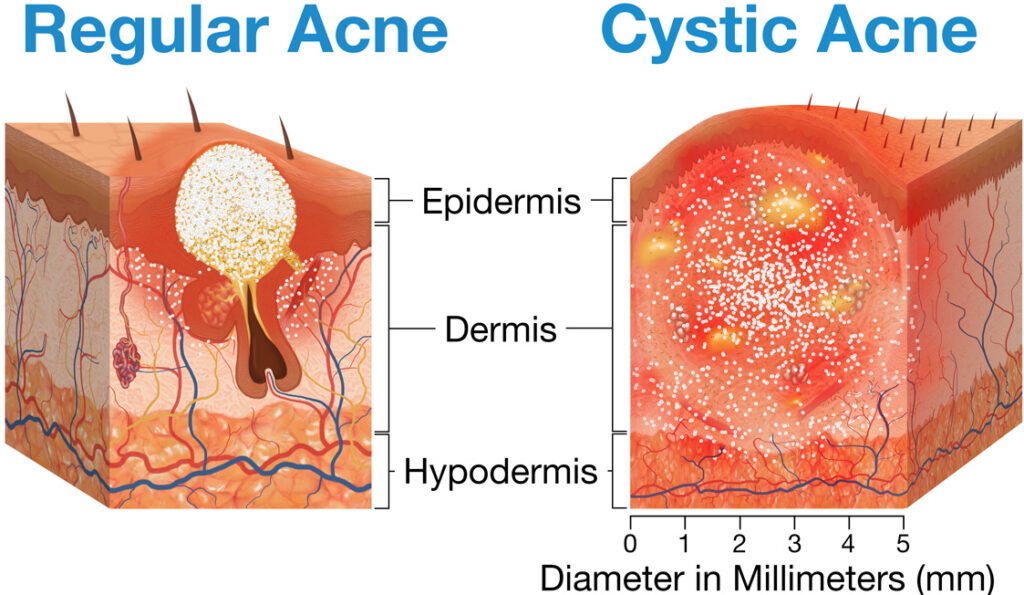Introduction
Cyst vs Pimple are common skin conditions that many people experience. While they may look similar at first glance, they have distinct characteristics and require different treatment approaches. Understanding the differences between cysts and pimples can help individuals manage their skincare effectively.
Characteristics of Cysts
Cysts are large, fluid-filled sacs that form beneath the skin. They often appear as round, raised bumps and can vary in size from a pea to a golf ball. Cysts are typically caused by infections, blocked oil glands, or ingrown hairs. They can develop anywhere on the body but are most commonly found on the face, neck, chest, and back.
Characteristics of Pimples
Pimples, also known as zits or acne, are small, inflamed bumps that develop on the skin’s surface. They are caused by excess oil production, bacteria, and dead skin cells clogging hair follicles. Pimples can range in size from tiny blackheads to larger, pus-filled lesions. They commonly occur on the face, shoulders, chest, and back.
Differences Between Cyst vs Pimple
Size and Severity
Cysts are generally larger and more severe than pimples. They can cause pain, swelling, and redness and may take longer to heal. Pimples, on the other hand, are smaller and less severe, although they can still be painful and unsightly.
Contents
Cysts are filled with fluid, pus, or other semi-solid material, giving them a soft, squishy texture. Pimples contain a mixture of oil, bacteria, and dead skin cells and may have a white or black head depending on their stage of development.
Treatment Options
Because of their size and severity, cysts often require medical intervention to treat effectively. Options may include drainage, corticosteroid injections, or surgical removal. Pimples can usually be treated with over-the-counter topical medications, such as benzoyl peroxide or salicylic acid, or prescription medications like retinoids or antibiotics.
How to Identify a Cyst vs Pimple
Differentiating between a cyst and a pimple can sometimes be challenging, especially in the early stages. However, there are some key differences to look out for.
Cysts are typically larger and deeper beneath the skin’s surface, whereas pimples are smaller and more superficial. Cysts may feel soft and fluctuant to the touch, while pimples are firmer and may have a visible white or black head.
Prevention Tips for Cyst vs Pimple
Preventing cysts and pimples involves adopting a consistent skincare routine and making healthy lifestyle choices. Some tips to reduce the risk of developing these skin conditions include:
- Cleansing the skin regularly with a gentle cleanser
- Avoiding harsh or abrasive skincare products
- Keeping hair clean and away from the face
- Avoiding picking or squeezing blemishes
- Eating a balanced diet rich in fruits, vegetables, and whole grains
Treatment Options for Cysts and Pimples
In addition to prevention strategies, there are several treatment options available for managing cysts and pimples.
For cysts, medical interventions such as drainage or corticosteroid injections may be necessary to reduce inflammation and promote healing. Pimples can often be treated with topical medications, including over-the-counter creams and gels, or prescription medications prescribed by a dermatologist.
Complications Associated with Cysts and Pimples
If left untreated, cysts and pimples can lead to complications such as infection, scarring, or hyperpigmentation. It’s essential to seek treatment promptly and avoid picking or squeezing blemishes, as this can worsen inflammation and increase the risk of complications.
Conclusion
In conclusion, cysts and pimples are common skin conditions that can affect individuals of all ages. While they may share some similarities in appearance, they have distinct characteristics and treatment options. By understanding the differences between cysts and pimples and adopting preventive measures, individuals can effectively manage their skincare and maintain healthy, clear skin.
FAQs (Frequently Asked Questions)
Are cysts and pimples contagious?
No, cysts and pimples are not contagious. They are caused by factors such as bacteria, oil production, and dead skin cells and cannot be spread from person to person.
What should I do if a cyst or pimple becomes painful or inflamed?
If a cyst or pimple becomes painful or inflamed, it’s essential to avoid touching or picking at it. Applying a warm compress may help reduce swelling and discomfort, but if symptoms persist, consult a healthcare professional for further evaluation and treatment.
How long does it take for a cyst or pimple to heal?
The healing time for a cyst or pimple can vary depending on its size, severity, and individual factors. In general, pimples may resolve within a few days to a week with proper treatment, while cysts may take longer and may require medical intervention for complete resolution.







